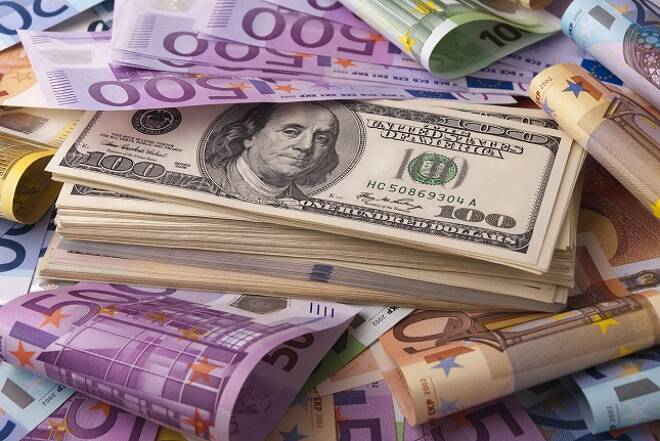Advertisement
Advertisement
The ECB Interest Rate Decision and Press Conference
By:
The ECB left interest and deposit facility rates unchanged today, in line with market expectations, whilst the EUR-USD eased from $1.05612 to $1.05577
The ECB left interest and deposit facility rates unchanged today, in line with market expectations, whilst the EUR-USD eased from $1.05612 to $1.05577 upon the announcement, any upside for the EUR upon expectations of a shift to normalization easing ahead of the ECB press conference.
The ECB also maintained its position on the asset purchase program, the Governing Council confirming that it will continue to make its purchases under the APP at the current monthly rate of €80bn until the end of this month and that, from April of this year, net asset purchases are intended to continue at a monthly pace of €60bn until December of this year, or beyond if necessary
Perhaps the key commentary was the ECB’s announcement that the Governing Council continues to expect the key ECB interest rate to remain at present or lower levels for an extended period of time, and well past the horizon of the net asset purchases. The ECB’s decision to leave the option of lower rates key to the ECB’s outlook.
Unsurprisingly, the ECB’s focus has remained on core inflation, which sits well below the ECB’s target, while the German government criticised the ECB’s decision to leave rates unchanged, despite the rise in geo-political risk ahead of elections in the Netherlands next week and in France next month.
The press conference certainly had a different tone when compared with the dovish sentiment in February, with salient points including:
- The increase in the annual rate of inflation has been attributed to rising energy and food prices, underlying price pressures remaining subdued, while the Governing Council will continue to look through HICP figures.
- If the outlook becomes uncertain, the Governing Council will be ready to lower rates, or increase or extended the APP, as deemed necessary.
- With real GDP at 0.4%, quarter-on-quarter, the economy growing at a similar pace to the 3rd quarter, economic risks are less pronounced, though risks remain titled to the downside.
- Economic growth for 2017 has been revised up from December’s projected 1.7% to 1.8%, with 2018 growth revised up from 1.5% to 1.6%.
- The annual rate of inflation has also been revised upwards for 2017 and 2018, while the 2019 forecast remained unchanged at 1.7%.
- Survey based data supports a continued expansion in the Eurozone economy according to February figures.
- Broad money M3 continues to grow at a robust pace, supported by the most liquid components, with M1 expanding by 8.1% in January, following an 8.8% increase in December, with loan growth also deemed solid.
- Need for very substantially accommodative monetary policy remains to bring inflation towards the ECB target.
- There remains the need for greater structural reforms by all member states of the Eurozone.
- Draghi outlined the successes of the ECB in what is referred to as 1st of the 3 blocks by the ECB:
- February PMI figures are at the highest levels since Apr-11.
- The economic sentiment index is at the highest level since 2011.
- The unemployment rate of 9.6% is the lowest since May 2009.
- The economy broadened further by sector and by country.
- Dispersion in growth between member countries are at the lowest levels since the 90s.
- Deflation pressures have disappeared.
- Loan rates have declined significantly with demand for loans rising considerably.
- The Governing Council has attributed 1.7% of the current annual rate of inflation and 1.7% of economic growth to the ECB monetary policy stimulus.
- The 2nd block relates to appropriateness and the Governing Council deems the current monetary policy position as appropriate.
- The 3rd block relates to risk.
- The ECB sees that the balance of risk has improved.
- The Governing Council has removed a sentence from its statement, this being ‘If warranted to achieve its objective, the ECB will use all tools at its disposal. The sentence being removed as the Governing Council acknowledges that there is no longer a sense of urgency in taking any further action to expand monetary policy.
- Draghi noted that the ECB has not discussed a TLTRO extension.
- On geo-politics, Draghi reiterated that the EUR is irrevocable and does not see any material risk to a possible breakup of the Eurozone.
- When Draghi was asked what the Governing Council would need to see before removing the option to drop rates further, Draghi noted that the key variable to monitor would be sustained wage growth.
- Finally, on the issue of Germany and the Eurozone’s trade surplus, Draghi noted that for the U.S administration to attack Germany is incorrect, with the ECB managing monetary policy and not Germany.
The EUR/USD moved from $1.05556 to $1.05951 through the conference, with the EUR having touched $1.06 levels during the press conference. So all in all, the ECB maintains its dovish position, while losing its sense of urgency.
About the Author
Bob Masonauthor
With over 20 years of experience in the finance industry, Bob has been managing regional teams across Europe and Asia and focusing on analytics across both corporate and financial institutions. Currently he is covering developments relating to the financial markets, including currencies, commodities, alternative asset classes, and global equities.
Did you find this article useful?
Latest news and analysis
Advertisement
